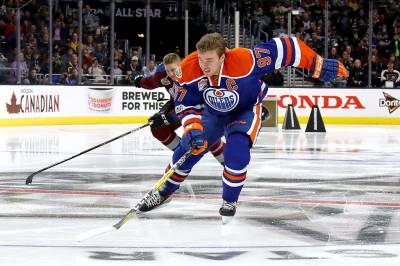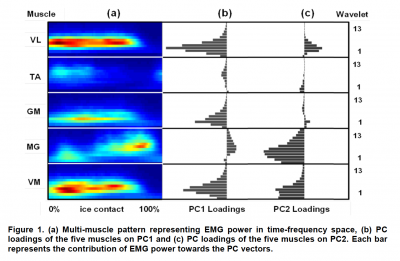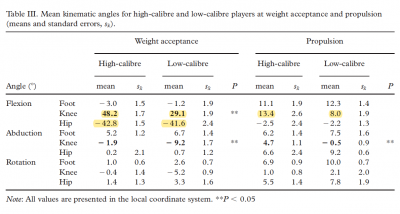There is currently a limited amount of information for the sport performance coach pertaining to stride mechanics and bio-motor mechanisms in competitive ice hockey. The goal of this article is to briefly outline several research articles that may be used by professionals to steer decision making and/or gain a deeper understanding of the kinematic and bio-motor applications involved in the sport. In other words, here is my brain dump! A mixture of brief research findings sprinkled with some pragmatic takeaways. Let’s start out by defining the hockey stride:

The skating stride is biphasic in nature and consists of a support and swing phase. The support phase can be further divided into single and double leg support (18% and 82% of support phase respectively) (Marino, 1983). Propulsion takes place during both double and single support during the outward rotation of the thigh, coinciding with initial extension of the hip and knee.
The Ankle:
Ankle mobility may play a role at increasing stride efficiency. Increased range of motion, in particular dorsiflexion, may aid the skater in assuming a lower skating position, thus reducing air resistance, while simultaneously increasing impulse, or the time the player has to produce force. In addition, pre-stretching the achilleas may increase kinetic energy thus increasing propulsion. Using electrogoniometers, researchers measured foot kinematics on the ice during a parallel start from defensive-zone face-off circle to offensive zone face-off circle. The acceleration phase occurred during the first 5 steps with steps 6-10 representing steady state. The following findings were recorded based on the average measurements of the sample size: (Pearsall et al., 2001)
- At the instant of single leg support phase, the skate was dorsiflexed 7.1 degrees
- As the double support phase began (loading prior to propulsion), ankle dorsiflexion reached 11.8 degrees
- Once push off was complete the swing phase began with 1.9 degrees of ankle dorsiflexion
- The skate was dorsiflexed throughout the entire stride cycle. Researchers have explained this as a means of preventing the tip of the skate from touching the ice causing unwanted friction
The paradox of ankle mobility is the need for stiffness around the joint during play. Hockey skates are engineered to provide structural support, and stability in a very different capacity than traditional running shoes. Due to the near frictionless environment, players must produce a force perpendicular to the skate blade to propel themselves forward. Doing this with minimal support/stiffness may impair force production. Robbing Peter (stability) to pay Paul (mobility) may pose to be a fruitless effort as many players have a personal preference regarding skate stiffness. Although more research on kinematics of the ankle is warranted, we have made a conscious effort to focus on this anatomical area daily. It starts when a potential player comes in for an evaluation and is a staple in our prehab work as a means of addressing limitations imposed from the repetitive posture of sport. Ankle dorsiflexion is one of many kinematic variables dictating stride efficiency, as such, it should be measured and managed.
Bio-Motor Considerations at the Hip:
Researchers from the University of Calgary set out to identify muscle activation patterns during accelerative hockey skating. In addition to collecting the EMG data, they compared and contrasted the movement strategies used by elite and recreational players. Each group performed 15 repetitions of a 30-meter sprint while muscle activity was measured in the tibialis anterior (TA), medial gastrocnemius (MG), vastus medialis (VM), vastus lateralis (VL), and gluteus medius (GM) (Buckeridge, von Tscharner, & Nigg, 2016)

Results:
When referencing the diagram, Figure 1a represents muscle activity across all subjects during the contact phase of acceleration. As we can interpret from this, the quads (VM, VL) and glute med (GM) are all integral and facilitated during on-ice acceleration. However, when we look deeper at the diagram, we can start to notice subtle differences. Figure 1b is the dominant muscle activation strategy used by elite players. Here we notice much bigger contributions from the hip abductors (GM) and the two knee extensor muscles (VM, VL). Contrasting this to Figure 1c, we notice that novice players relay much more on their medial gastrocnemius as a plantar flexor and that there is an inverse contribution from the vastus lateralis (VL) in additional to minimal facilitation of the glute med (GM). In essence, elite players use a hip-knee extensor pattern to build speed, while novice/recreational players rely on ankle plantar flexor strategies, at the expense of the vastus lateralis (VL) and glute med (GM) during the late propulsive phase of acceleration.
Coupled with varying degrees of muscle activation strategies, (Upjohn, Turcotte, Pearsall, & Loh, 2008)attempted to quality the difference in stride efficiency from a kinematic standpoint between recreational and College level hockey players using four synchronized digital video cameras, and a skating treadmill. Each participant completed three 1-min skating trials separated by 5 min of rest. The results were as follows:

- Although stride rates were similar (59.9 strides/min in high caliber vs 55.1 strides/min in low caliber), high caliber skaters achieved greater skating velocities
- High caliber skaters had superior stride length and stride width (stride length allows one to cover more ice, stride width may increase forward speed by enabling a more oblique skate orientation relative to the skating surface)
- High caliber skaters demonstrated greater hip flexion and knee flexion angles during weight acceptance.An increased knee flexion at weight acceptance suggests the ability to use the stretch shortening capacity of the quads for upcoming concentric contraction during propulsion
- High caliber skaters had a greater rate of knee extension and plantar flexion at propulsion (due to increased ROM during weight acceptance)
Adductor Magnus:
The adductor magnus is one of four adductor muscles responsible for hip extension and adduction. During the mechanics of the hockey stride, the adductor magnus is responsible for eccentrically decelerating the stride leg during propulsion (abduction, extension, external rotation). It has long been speculated that muscle strains, particularly in this anatomical region, are the byproducts of these repetitive eccentric forces (Tyler, Nicholas, Campbell, & McHugh, 2001). Skating velocity has also been correlated with increased facilitation of the adductor magnus. Using surface EMG on a skating treadmill, researchers found that as velocity increased from 3.3 m/s-6.66 m/s, the adductor magnus exhibited the greatest overall activation magnitude and activation time. Kinematic data revealed that as skating speed increased, total range of motion at the hip, knee and ankle did not alter suggesting that even at low speeds the length of passive and active structures, including the adductor magnus, were at maximum (Chang, Turcotte, & Pearsall, 2009).
Adductor injury rates were most prevalent in NCAA men’s soccer and NCAA men’s ice hockey during a seven-year investigation into the prevalence of hip flexor and adductor strains for 25 respective NCAA sports. Non-contact compromised the largest portion of these injuries (Eckard et al., 2017). Recurrence rates have been reported to be as high as 23.5% for the hockey playing population with an increase of cumulative incidence rate per year of 1.32 injuries/100 players. Of particular interest in the National Hockey League (NHL) is the incident density rate of these injuries is five times more prevalent during training camp as compared to the regular season (Emery, Meeuwisse, & Powell, 1999)
Relevancy for performance coaches:
- The hockey stride is a SKILL. The best way to improve it is on the ice (Both rate and range of motion were superior in high caliber skaters. Perhaps the “lowest hanging fruit” for performance coaches is to improve range of motion. Increased ROM = > Impulse)
- Players perform an average of 55.1-59.9 strides/min. (The quads need to be STRONG! Relative to increase range of motion, perhaps none as important as isometric transfer from eccentric to concentric during propulsion. Isometric strength may be the most ignored in traditional programming. Add this to program!)
- > ROM = > Extension velocity
- According to Marino there is a larger double support phase (82% than single support phase (18%) (Have a steady menu of non-supported single leg work, supported single leg work and bi-lateral lower body lifts)
- Often, as with most muscle strains, the injury occurs during vigorous eccentric contraction. In addition, the insertion site of the adductors is relatively small and blood supply to the pubic bone in this region is relatively poor which further may predispose an athlete to injury. During the off-season, it’s important to take these biomechanical considerations into account during programming. Here are a few ways we will work this anatomical area into our protocol.
- PRI Lazy Bear: Quadruped Breathing seeks to reorient the pelvis and internally rotate the ribs thus restoring length tension between the anterior and posterior musculature of the hip.
- KB Reverse Crunch: Goal is to internally rotate the ribs while posteriorly tilting the pelvis providing inhibition to the hip flexors
- Slide Board: Unlike the hockey stride (open chain recovery), the slide board taxes the adductors eccentrically and concentrically during the recovery phase. The goal is to strengthen this anatomical region with each push
- Copenhagen Side Planks: The athlete performs a side plank with his/her top leg straight and resting on a bench/box while the bottom leg is not providing structural assistance thus taxing the adductor complex concentrically
Buckeridge, E., von Tscharner, V., & Nigg, B. M. (2016). LOWER LIMB MUSCLE RECRUITMENT STRATEGIES DIFFER BETWEEN ELITE AND RECREATIONAL ICE HOCKEY PLAYERS.Paper presented at the ISBS-Conference Proceedings Archive.
Chang, R., Turcotte, R., & Pearsall, D. (2009). Hip adductor muscle function in forward skating. Sports Biomechanics, 8(3), 212-222.
Eckard, T. G., Padua, D. A., Dompier, T. P., Dalton, S. L., Thorborg, K., & Kerr, Z. Y. (2017). Epidemiology of hip flexor and hip adductor strains in National Collegiate Athletic Association athletes, 2009/2010-2014/2015. The American journal of sports medicine, 45(12), 2713-2722.
Emery, C. A., Meeuwisse, W. H., & Powell, J. W. (1999). Groin and abdominal strain injuries in the National Hockey League. Clinical Journal of Sport Medicine, 9(3), 151-156. doi:10.1097/00042752-199907000-00006
Pearsall, D., Turcotte, R., Lefebvre, R., Bateni, H., Nicolaou, M., Montgomery, D., & Chang, R. (2001). Kinematics of the foot and ankle in forward ice hockey skating.Paper presented at the ISBS-conference Proceedings archive.
Tyler, T. F., Nicholas, S. J., Campbell, R. J., & McHugh, M. P. (2001). The association of hip strength and flexibility with the incidence of adductor muscle strains in professional ice hockey players. The American journal of sports medicine, 29(2), 124-128.
Upjohn, T., Turcotte, R., Pearsall, D. J., & Loh, J. (2008). Three-dimensional kinematics of the lower limbs during forward ice hockey skating. Sports Biomechanics, 7(2), 206-221.